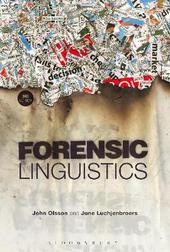
|
Forensic Linguistics
Paperback / softback
Main Details
| Title |
Forensic Linguistics
|
| Authors and Contributors |
By (author) Dr John Olsson
|
|
By (author) June Luchjenbroers
|
| Physical Properties |
| Format:Paperback / softback | | Pages:368 | | Dimensions(mm): Height 234,Width 156 |
|
| Category/Genre | linguistics |
|---|
| ISBN/Barcode |
9781441170767
|
| Classifications | Dewey:363.25 |
|---|
| Audience | | Tertiary Education (US: College) | | Professional & Vocational | |
|---|
|
Publishing Details |
| Publisher |
Bloomsbury Publishing Plc
|
| Imprint |
Bloomsbury Academic USA
|
| Publication Date |
5 December 2013 |
| Publication Country |
United States
|
Description
Now in its third edition, this practical introduction to forensic linguistics is required reading for students of language and the law. It includes: new chapters on identifying forensic texts and important interactional aspects of the language used in legal contexts an additional chapter on forensic phonetics by Harry Hollien, a world renowned forensic phonetician an appendix of forensic texts for student study, and even more exercises and suggestions for further reading a companion website with a repository of statements, notes and examples referred to throughout the text.
Author Biography
John Olsson was a lecturer in Forensic Linguistics in both the School of Linguistics and the School of Law at Bangor University, Wales, and was head of the Forensic Linguistics Institute. Additionally, he taught forensic linguistics online. June Luchjenbroers is Senior Lecturer in Linguistics at Bangor University, Wales.
Reviews[A]n extremely useful book for students and practitioners in a broad range of fields ... [including] law students, practising lawyers, students of applied linguistics, criminologists police officers ... One of the strengths of the book is that real-life legal cases are referred to when illustrating theoretical points ... [A]n informative and accessible text. * New Zealand Studies in Applied Linguistics * This book is vital reading for students and researchers of forensic linguistics and will undoubtedly help to cement interest in the field. It is stunningly comprehensive, addressing a generous range of forensic-related themes and issues: from cyber-terrorism to suicide notes. It takes in spoken, written and computer-mediated communication, examines, in detail, key studies and cases, and is written in a limpid and engaging style. The book also usefully includes a number of practical exercises and insightful commentaries which will prove invaluable to readers wishing to sharpen their forensic analytical sensibilities. This new edition of Forensic Linguistics is a joy to read, and I will be recommending it to all of my students interested in the interface between language and society. -- Kevin Harvey, Lecturer in Applied Sociolinguistics, University of Nottingham, UK
|